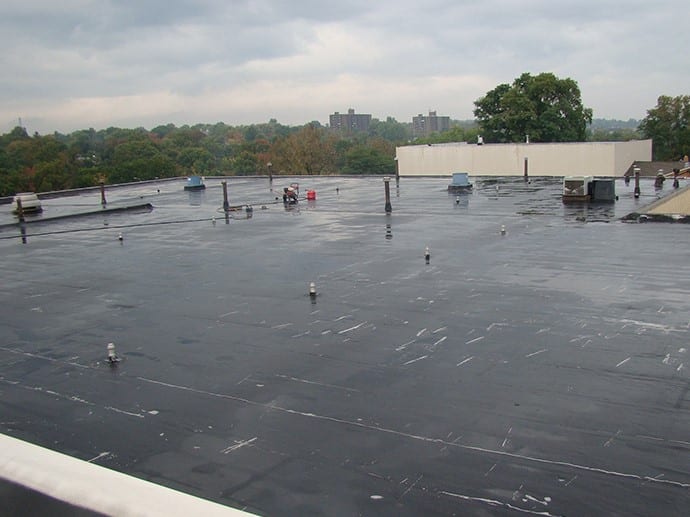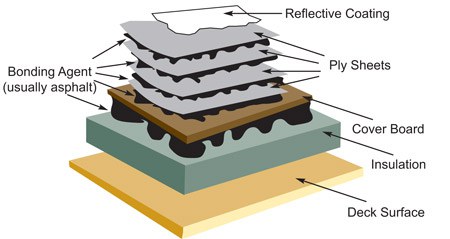Asphalt Layers or coal tar.
We provide complete home renovation services.


Built Up Roofing System (BUR) is one of the popular options when it coms to commercial and industrial buildings with flat roofs.
Built-Up Roofing (BUR) system, is known for its durability and longevity.
A built-up roof, or BUR, is a roofing system for flat or low-sloped roofs. It combines several layers of material built on top of each other. Built-up roofs are made from at least three materials: ply sheets, layers of bitumen or asphalt, and a surfacing material like stone or gravel. The modern BUR’s base is thick roof insulation with a cover board. On top of the board are alternating layers of bitumen and ply sheets, such as roof felt. The bitumen can be “cold,” which means an adhesive application, or “hot” applied with a torch. The top layer is a surface material such as small stones or gravel. Some BURs, especially in commercial spaces, have a UV layer under them for heat resistance.
BUR systems can be installed on a wide range of buildings, including commercial and industrial.
BUR systems are a durable and long-lasting option for flat roofs industrial and residential.
A BUR system provides a durable, waterproof layer on top of a building. The layers of the BUR system work together to create a barrier that keeps water from penetrating the building. The base layer is first applied to the roof deck, and then each subsequent layer is applied on top of it, with each layer being adhered to the previous layer with hot asphalt or another adhesive material.
The top layer of the BUR system is typically a layer of gravel or other materials that protect it from the elements. This layer also helps to reflect sunlight and prevent the roofing materials from becoming too hot, which can lead to premature aging and cracking.
The term “hot” refers to how the layers are installed. The asphalt layers are heated, so they liquefy and form a bond with the felt layers. In general, though, hot built-up roofing doesn’t perform as well as cold built-up roofing in extreme weather. The installation is generally more complex and weather-dependent.
With cold built-up roofing insulation, the asphalt layers are bonded with the felt layers with an adhesive. As a result, cold built-up roofing is more weather-resistant than hot built-up roofing, and there are no toxic fumes to worry about. Cold installation can also be done in virtually any weather, provided it’s not raining or snowing.
Ballasted built-up roofing is not installed using heat or any adhesive. Instead, the layers of asphalt and felt are kept in place with a top layer of heavy stones. The top-layer stones can be up to 2 inches in diameter and provide enough weight to keep all the layers in place.

The essential elements of built-up roofing have remained the same. While modern innovations and new materials have been introduced, your basic built-up roofing system will consist primarly of these components:
Installation Complexity: BUR systems require specialized installation techniques, which can increase the cost and complexity of the installation process. Proper installation requires skilled workers who are trained in the specific installation methods and materials used in BUR systems.
Weight: Built-up roofing systems are relatively heavy, which can concern buildings with weight restrictions. Additional structural support may be required to accommodate the weight of the built-up roofing materials.
Environmental Concerns: Using hot asphalt in BUR systems can raise environmental concerns due to the emissions of toxic fumes produced during installation. Additionally, removing and disposing of a BUR roof at the end of its service life can be complicated and requires specialized handling and disposal techniques.
Suppose your BUR system fails at some point in its expected lifespan. In that case, there are repair options that may extend its longevity. Below are two primary repair options for your built-up roof system.
Spray foam roof coatings minimize tear-offs while helping to maintain a seamless membrane. As a bonus, SPF-sprayed roofs become sustainable post-warranty.
Smooth built-up roof systems may benefit from a silicone coating. The primary appeal of silicone coatings is its low cost compared to other repair or replacement options. A silicone coating ranges between $2-$4 per square foot, which essentially cuts your expenses by more than half.
However, you shouldn’t apply a silicone coating to a gravel BUR.
The cost of a BUR roofing system depends on different factors, like the size of the roof, the type of materials used, and the complexity of the installation. In general, BUR systems are more expensive than other roofing systems due to the labor-intensive installation process and the high cost of materials. generally, a BUR System can range from $3 to $6 per square foot.
Regular Roof inspections are the easiest way to protect your BUR roof . Once roofers identify a small problem, you should address it ASAP rather than allowing the situation to linger and cause more extensive damage.
In addition, BUR Systems should have reapplied UV protective layers every five years to maintain protection from damaging sunlight. However, an inspector should examine the seals and flashing before reapplication to ensure proper fitting. If cracks emerge, you’ll want to reseal them before applying the new UV protection layer.
Similarly, damaged flashing must be replaced before reapplication.
A Built-Up Roof is a popular option for architects and building owners for its durability, widespread adoption by many roofers, and its energy efficiency. From the many roof substrates to choose from, built-up roofing should be on your shortlist.


Subscribe to our newsletter and get update in your inbox.
© All Copyright 2024 by ARC - Austin Roofing Company